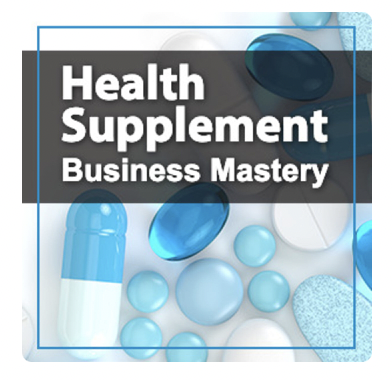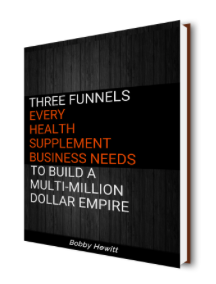
In part 1 of this two part article on marketing funnels for online supplement companies, we looked at how marketing funnels are key to exponential growth when selling health products and natural health supplements direct to consumers online.
And we defined a marketing funnel as:
A system that helps track the stages consumers travel through, to eventually make a buying decision.
We unpacked the rocket fuel funnel strategy and how to look at the 3 marketing funnels every health supplement business needs to CRUSH IT online.
Today we’re diving into part 2, where we look at each of those three funnels in more depth. Enjoy!!!
The Content Funnel
The first of the three funnels is the Content Funnel. It’s the funnel at the very top. Some marketers refer to it as the acquisition funnel because it focuses on getting opt-ins. But it can also be made up of pure content that is designed to pre-frame the next step.
The Content Funnel starts with the catalyst and the hook and looks like this:
Traffic Source (ad, email, etc.) > Hook > Click
The catalyst can be a Facebook ad, an email or any piece that’s connected to the hook, which is the attraction factor that draws in your target audience. It is designed simply to get the click to the next step.
The Content Funnel can and should do each of the following:
- Pre-frame the sale and simply inform and ask for a click to the “next step” sales page as in the case of an advertorial.
- Cookie the audience to re-target them later with ads.
- (OPTIONAL) Get an email opt-in and take them down a good-will value added journey by providing more content. Sometimes there’s a tripwire offer attached immediately after or in the lead magnet content piece itself.
- Leads directly to the next funnel, the Sales Funnel.
The Sales Funnel
The Sales Funnel is the next in the hierarchy of funnels and it’s the place most marketers spend their time on, sadly at the expense and detriment of the other funnels. Marketers often try to combine the Content Funnel with the Sales Funnel in an attempt to short circuit the system into a single funnel and get a customer right away in one single step. This is the classic self-liquidating offer approach.
The Sales Funnel usually has several offers presented as “OTOs” to One-Time-Offers that are siphoned out to the visitor at each step of the Sales Funnel. First the main offer, then sometimes a bump offer and onward to a series of up-sells and or down-sells.
A bump offer as mentioned earlier is the classic, “do you want fries with that” offer. Only meant to “bump” up the average order value of the single purchase visit but it also complements the main offer.
An up-sell offer is, just what you think. You already bought the main offer and possibly the bump offer, now you’re presented with a different offer, that can and should also compliment the main offer. But it’s only limited to the marketer. You can string as many up-sells and down-sells together in a chain of additional sales as you like or as the market will bear. Sometimes a market is so voracious that they won’t mind 4 or more up-sells.
The strategy Torchlight uses to sell flashlights is quite simple and exactly what I’m seeing in other offers that you can apply:
Up-sell 1 – Buy more of the same (You just bought one flashlight, do you want to buy 3 more?)
Up-sell 2 – Add on a Bigger version of the same product (a bigger flashlight) for an additional $10
Up-sell 3 – Batteries (Accessory or complimentary product)
One way to think about what up-sell offer to present is to ask, what’s the next problem a buyer is going to run into?
The answer is the best offer for the next up-sell. But the key is that each up-sell needs to enhance the initial purchase. You don’t want to create a reaction from your buyer that makes them wonder why they should buy this up-sell. Isn’t the first thing I bought supposed to solve my problem? Then they start having doubts about buying that initial front-end offer and won’t buy your up-sell, and tarnish your trust.
Here are three up-sell strategies to get you started:
Up-Sell Based On Value
Up-sell more of the same product that the customer just purchased. This works well for health supplements that you know you’ll need more of down the road. The real secret to making this work comes down to the value, you have to offer a deal so good it’s tough to pass up. So what works here is usually a discounted price, lower than what they just paid. This can either be as a straight discount like 50% Off or as a BOGO, buy one get one or any variation, buy two bet one, buy four get two, etc.
Up-Sell Based On Speed And Or Ease Of Implementation
With this strategy you’re up selling customers a faster and or easier way to get the result they want to get from the front-end purchase. You’re essentially selling speed here, which is why it works and is not perceived as an incomplete offer, avoiding the “isn’t the first thing I bought supposed to solve my problem?” question. You can achieve the results you want with the front-end purchase but if you want to get there faster or with less work, this up-sell is for you.
A great example is if you sell a weight-loss front-end product and offer a detox up-sell as a way to jump start your way to better health or speed up your weight-loss.
Up-Sell Based On The Future
This strategy only works by presenting a future problem that your buyer doesn’t have yet but they will have as a result of using the front-end product they just bought.
They key is that it’s a good problem. So in this strategy you introduce the good problem they don’t have yet but will have after getting results from your front-end and offer a solution to solve that problem. When done in the right way, this also reinforces the confidence in the front-end purchase they just made.
A down-sell offer is one that is both offered as a result of a prospect saying no or not taking an up-sell and is a down step to what they said no to.
So an example or down-sell strategy would be to offer the same thing or less of the same thing at a decreased price. The key is that you can’t just decrease the price if they say no. That will devalue the product and strain trust. The down-sell offer has to make sense. Meaning there needs to be a reason why you’re offering this new option.
Let’s say they just said “no thanks” to an up-sell offer that presented an inversion table for $299 you could offer a step down by presenting a down-sell for the same inversion table but in the down-sell the offer is for 3 easy payments, making the total today lower. The reason why might be as a way to make it easier for them to pay, taking an assumptive standpoint that they turned down the initial $299 up-sell because of high price.
The Follow Up Funnel
The Follow Up Funnel is like the caboose on a train. Without it you’ll never complete the full picture and support your business with a strong back end.
Because those who are really successful with this business model know that the money is actually in the back end and the front end is simply just a way to get a customer. Therefore the selling is not over once a buyer goes through your sales funnel.
The Follow Up Funnel can be broken up into the following two sub-funnels.
One for buyers and one for non-buyers.
The Buyer Follow Up Funnel focuses on:
- Retention and habit creation for health supplement companies. Getting buyers to actually take and use the product on a regular basis and in the proper dosage.
- Increasing life time value of your customers by indoctrinating them into your mission and introducing them to your other products.
- Giving them a second chance to buy. Through a series of emails and informative landing pages with offers, if they passed up on specific up-sells and or down-sells in your funnel, giving them another opportunity to buy.
The Non-Buyer Follow Up Funnel focuses on:
- Getting them back, in order to take an action that they didn’t take the first time. Usually through re-targeting ads or push notifications, if you don’t have their email address or or other contact information. You will have that information if you have a content funnel with a micro-commitment on your sales page for a step one opt-in before getting to the order/cart page. This can also cannibalize your front-end sales, so you should test it to see if it’s worth losing the short-term for the long-term gain of being able to contact prospects via email or phone.
Connecting It All Together
The successful marketers build a funnel strategy that runs through all three of the core funnels for each visitor.
Each funnel builds on the other to create a synergistic effect.
The Content Funnel brings in the visitor and pre-frames them for the Sales Funnel, which further educates and sells them so that you can then use your Follow Up Funnel to maximize the overall value.
But underlying all of those funnels is one single funnel strategy, the principle that…
Prospects need different funnels at different stages of their buying and trust building journey with you.
The only question is how are you going to help them through that journey?
Discover the 3 funnels that can help your health supplement business succeed.

Listen to the Health Supplement Business Mastery Podcast for for dietary supplement entrepreneurs and marketers.



